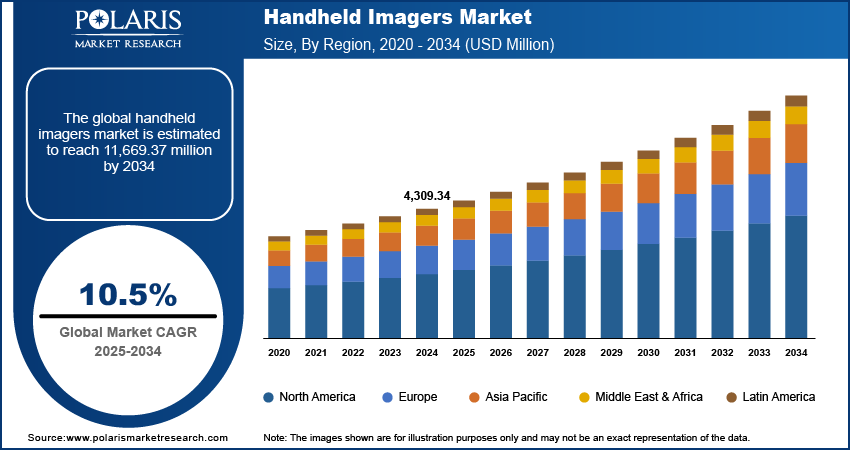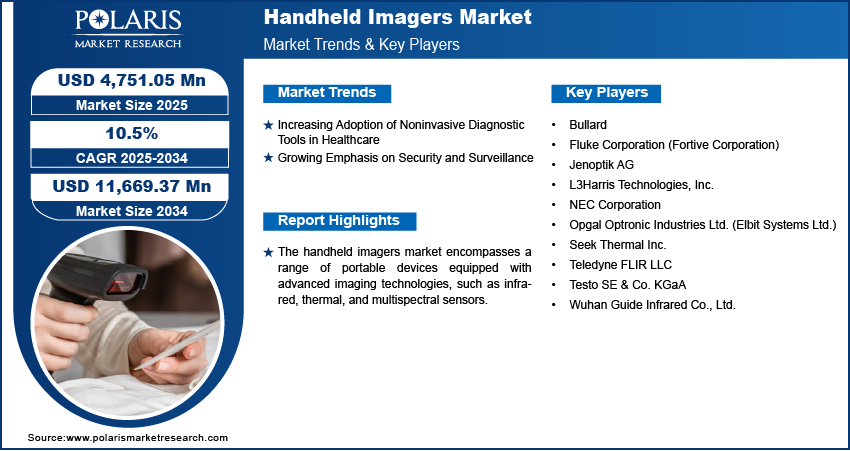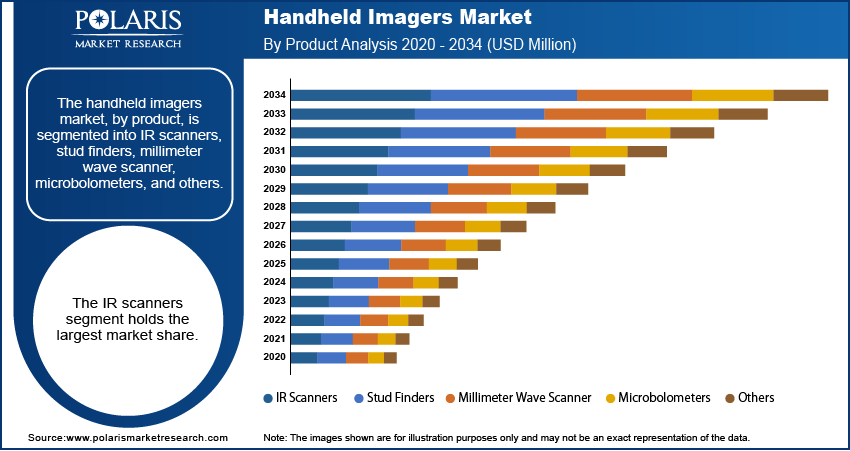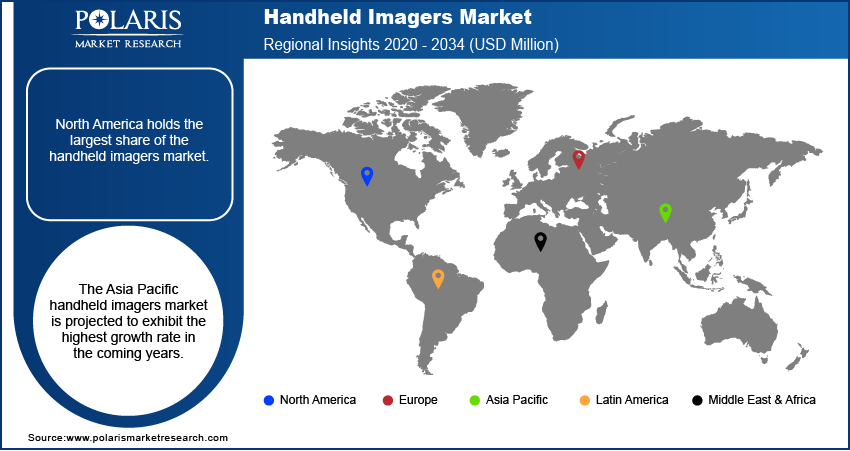
Handheld Imagers Market Size, Share, & Industry Analysis Report
: By Product (IR Scanners, Stud Finders, Millimeter Wave Scanner, Microbolometers, and Others), By Application, and By Region – Market Forecast, 2025–2034
- Published Date:May-2025
- Pages: 120
- Format: PDF
- Report ID: PM5683
- Base Year: 2024
- Historical Data: 2020-2023
Market Overview
The handheld imagers market size was valued at USD 4,309.34 million in 2024. It is projected to grow from USD 4,751.05 million in 2025 to USD 11,669.37 million by 2034, exhibiting a CAGR of 10.5% during 2025–2034.
The handheld imagers market comprises portable devices designed for real-time data capture and visualization. These devices use technologies such as infrared, thermal, and hyperspectral imaging. They are engineered for high-precision tasks across various sectors, including industrial maintenance for detecting electrical and mechanical faults, security for surveillance, agriculture for crop assessment, and medical diagnostics. Handheld imagers feature advanced sensors, embedded processors, and ergonomic designs, enabling quick image acquisition and analysis without stationary setups. The market is experiencing growth driven by the increasing adoption of high-precision imaging solutions and the expanding use of handheld imaging devices in medical and veterinary diagnostics. The rising focus on operational efficiency in manufacturing, energy, and utility sectors is also contributing to growth, as these sectors adopt predictive maintenance tools.
The increasing demand for noninvasive diagnostic tools in healthcare and the integration of AI and machine learning algorithms are key drivers. The adoption of handheld imagers in healthcare is further supported by demographic trends such as aging populations and the rising prevalence of chronic diseases. The increasing focus on security and surveillance across the public and private sectors globally is also a significant driver. Handheld imagers provide portable and flexible solutions for law enforcement, border control, transportation hubs, and critical infrastructure facilities. Technological advancements, including high-resolution sensors, improved image processing algorithms, and enhanced thermal imaging capabilities, continue to expand the applications and functionalities of handheld imagers.

To Understand More About this Research: Request a Free Sample Report
Market Dynamics
Increasing Adoption of Noninvasive Diagnostic Tools in Healthcare
The healthcare sector is increasingly embracing noninvasive diagnostic tools. Handheld imagers, particularly thermal and infrared types, offer a portable and efficient way to capture physiological data without direct contact with the patient. This is especially valuable for early disease detection, monitoring chronic conditions, point-of-care diagnostics, and diagnostic imaging services. The rising prevalence of chronic diseases globally necessitates continuous and convenient monitoring solutions, further fueling the demand for these devices. The point-of-care availability of handheld imagers allows for immediate diagnostic capabilities, aiding healthcare providers in making quick and accurate decisions. Thus, the rising adoption of noninvasive diagnostics tools the medical field boosts the handheld imagers market growth.
Growing Emphasis on Security and Surveillance
The escalating concerns about security and the rising need for advanced surveillance technologies are significant drivers. Handheld imagers, including thermal and millimeter-wave scanners, provide versatile solutions for security applications across various sectors such as law enforcement, border control, transportation hubs, and critical infrastructure. Official police reports and public safety data often show trends in specific types of crime that handheld imagers can help address. For instance, 1,915 suitcases were reported stolen on trains and at stations in the UK in 2024, a 36.9% increase compared to 2023.
Portability of handheld imagers allows for rapid deployment and efficient screening in diverse environments. Thus, the demand for handheld imagers is fueled by increasing government investments in defense and surveillance, as well as the rising adoption of technologies such as AI and IoT for enhanced threat detection. The ability of handheld imagers to offer real-time monitoring and efficient security inspections in a portable form factor is a key factor driving their increased adoption in the security and surveillance sector.
Rising Demand for Predictive Maintenance in Industries
The increasing focus on operational efficiency and cost reduction across industries is driving the demand for predictive maintenance technologies, where handheld imagers play a crucial role. Thermal imagers, in particular, are used to detect anomalies and potential failures in machinery and electrical systems by identifying temperature variations. Early detection of these issues helps prevent costly downtime and ensures the longevity of equipment. Government initiatives and industry regulations are also playing a vital role in promoting the adoption of predictive maintenance technologies. For example, the US government allocated USD 500 million in 2020 for the development and deployment of IoT-based smart manufacturing systems. The ability of handheld imagers to provide portable and immediate thermal analysis for predictive maintenance is a significant factor contributing to their growing demand in the industrial sector.

Segment Insights
Market Assessment – By Product
The handheld imagers market, by product, is segmented into IR scanners, stud finders, millimeter wave scanner, microbolometers, and others. The IR scanners segment holds the largest share, owing to their extensive application across a wide array of industries. Infrared scanners are widely utilized in industrial maintenance for thermal inspections, in the building and construction sector for identifying insulation issues and moisture detection, and increasingly in healthcare for temperature screening and diagnostics.
The millimeter wave scanner segment is anticipated to exhibit the highest growth rate during the forecast period. This rapid growth is fueled by the increasing demand for advanced security screening solutions, particularly in transportation hubs such as airports and railway stations, as well as in critical infrastructure facilities. Millimeter wave technology offers the capability to detect concealed objects with high precision and without physical contact, making it an invaluable tool for enhancing security measures. Furthermore, ongoing technological developments are expanding the potential applications of millimeter wave scanners beyond security, including areas such as non-destructive testing and quality control in manufacturing.
Market Evaluation– By Application
The market, by application, is segmented into construction, industry, security, medical, and others. Currently, the industry segment accounts for the largest share. This significant presence is driven by the widespread use of these devices for various industrial applications. Handheld imagers are crucial tools for predictive maintenance, quality control, and process monitoring across numerous industrial sectors, including manufacturing, energy, and automotive. Their ability to provide real-time thermal analysis and detect potential equipment failures or anomalies non-invasively makes them indispensable for ensuring operational efficiency and reducing downtime.
The medical application segment is anticipated to experience the highest growth rate during the forecast period. This rapid expansion is driven by the increasing integration of handheld imagers in diagnostic procedures, patient monitoring devices, and point-of-care applications. The portability and non-contact nature of these devices offer significant advantages in various medical settings, from detecting temperature anomalies for initial screenings to assisting in the diagnosis of specific conditions. Furthermore, the development of more sophisticated handheld imagers with enhanced imaging capabilities and integration with telemedicine platforms is broadening their utility in healthcare.

Regional Footprint
The handheld imagers market demonstrates a global presence, with key regions including North America, Europe, Asia Pacific, Latin America, and the Middle East & Africa. Each region exhibits unique dynamics influenced by factors such as industrial development, healthcare infrastructure, security concerns, and technological adoption rates. North America and Europe have historically been significant due to their well-established industrial sectors and early adoption of advanced technologies. Asia Pacific is emerging as a high-growth region, driven by rapid industrialization and increasing investments in various sectors. Latin America and the Middle East & Africa represent with growing potential, influenced by increasing infrastructure development and rising security awareness.
North America holds the largest share, owing to the region's strong industrial base, particularly in manufacturing and aerospace, where handheld imagers are extensively used for maintenance and quality control. Furthermore, the presence of advanced healthcare infrastructure and a high rate of technology adoption in the medical sector contribute significantly to the large share. Stringent safety regulations and a focus on technological advancements across various industries further propel the demand for handheld imagers in North America, making it the leading region in terms of size.
The Asia Pacific handheld imagers market is projected to exhibit the highest growth rate over the coming years. This rapid growth is fueled by the region's swift industrialization, particularly in countries such as China and India, leading to increased demand for handheld imagers in manufacturing and infrastructure development. Additionally, growing investments in healthcare infrastructure and rising security concerns across the region are driving the adoption of these devices. The increasing awareness regarding predictive maintenance practices in industries and the rising adoption of advanced technologies in various sectors are key factors contributing to the high growth potential of Asia Pacific.

Key Players and Competitive Insights
A few of the major players in the handheld imagers market include Fluke Corporation (Fortive Corporation); Teledyne FLIR LLC (Teledyne Technologies Incorporated); Testo SE & Co. KGaA; Seek Thermal Inc.; Opgal Optronic Industries Ltd. (Elbit Systems Ltd.); L3Harris Technologies, Inc.; Jenoptik AG; NEC Corporation; Bullard; and Wuhan Guide Infrared Co., Ltd. These companies offer a diverse range of handheld imagers catering to various applications across industrial, security, medical, and other sectors.
The competitive landscape of the handheld imagers market is characterized by a mix of well-established global players and emerging regional companies. Competition is driven by factors such as product innovation, technological advancements in imaging sensors and software, price points, and the breadth of application coverage. Key strategies adopted by players include new product development with enhanced features, strategic partnerships and collaborations to expand reach, and focusing on specific application niches to gain a competitive edge. The market also sees increasing emphasis on integrating features such as wireless connectivity, cloud-based data analysis, and artificial intelligence to enhance the functionality and user experience of handheld imagers.
Fluke Corporation, located in Everett, Washington, USA, offers a comprehensive portfolio of handheld thermal imagers used extensively for industrial maintenance, building diagnostics, and electrical inspections. Their offerings range from entry-level models to high-performance imagers with advanced analysis capabilities, catering to a wide spectrum of professional users. Fluke's handheld imagers are known for their ruggedness, reliability, and user-friendly interfaces, making them relevant across various industrial and commercial applications.
Wuhan Guide Infrared Co., Ltd., based in Wuhan, China, specializes in the development and manufacturing of infrared thermal imaging technology and offers a variety of handheld thermal imagers. Their products find applications in industrial inspections, security and surveillance, firefighting, and medical diagnostics.
List of Key Companies
- Bullard
- Fluke Corporation (Fortive Corporation)
- Jenoptik AG
- L3Harris Technologies, Inc.
- NEC Corporation
- Opgal Optronic Industries Ltd. (Elbit Systems Ltd.)
- Seek Thermal Inc.
- Teledyne FLIR LLC (Teledyne Technologies Incorporated)
- Testo SE & Co. KGaA
- Wuhan Guide Infrared Co., Ltd.
Handheld Imagers Industry Development
- March 2025: Teledyne FLIR, a part of Teledyne Technologies Incorporated, introduced the Ocean Scout Pro, a new handheld marine thermal camera. This device is designed for public safety professionals and mariners, offering enhanced situational awareness with a 640 x 480 thermal detector and a 500-meter detection range.
Handheld Imagers Market Segmentation
By Product Outlook (Revenue – USD Million, 2020–2034)
- IR Scanners
- Stud Finders
- Millimeter Wave Scanner
- Microbolometers
- Others
By Application Outlook (Revenue – USD Million, 2020–2034)
- Construction
- Industry
- Security
- Medical
- Others
By Regional Outlook (Revenue – USD Million, 2020–2034)
- North America
- US
- Canada
- Europe
- Germany
- France
- UK
- Italy
- Spain
- Netherlands
- Russia
- Rest of Europe
- Asia Pacific
- China
- Japan
- India
- Malaysia
- South Korea
- Indonesia
- Australia
- Rest of Asia Pacific
- Middle East & Africa
- Saudi Arabia
- UAE
- Israel
- South Africa
- Rest of Middle East & Africa
- Latin America
- Mexico
- Brazil
- Argentina
- Rest of Latin America
Handheld Imagers Market Report Scope
|
Report Attributes |
Details |
|
Market Size Value in 2024 |
USD 4,309.34 million |
|
Market Size Value in 2025 |
USD 4,751.05 million |
|
Revenue Forecast by 2034 |
USD 11,669.37 million |
|
CAGR |
10.5% from 2025 to 2034 |
|
Base Year |
2024 |
|
Historical Data |
2020–2023 |
|
Forecast Period |
2025–2034 |
|
Quantitative Units |
Revenue in USD million and CAGR from 2025 to 2034 |
|
Report Coverage |
Revenue Forecast, Market Competitive Landscape, Growth Factors, and Industry Insights |
|
Segments Covered |
|
|
Regional Scope |
|
|
Competitive Landscape |
|
|
Report Format |
|
|
Customization |
Report customization as per your requirements with respect to countries, regions, and segmentation. |
How is the report valuable for an organization?
Workflow/Innovation Strategy
The handheld imagers market has been segmented into detailed segments of product and application. Moreover, the study provides the reader with a detailed understanding of the different segments at both the global and regional levels.
Market Entry Strategies
A key growth strategy in the market involves continuous product innovation, focusing on enhanced resolution, thermal sensitivity, and integration of artificial intelligence for advanced analytics. Expanding market penetration across diverse applications, such as healthcare for noninvasive diagnostics and agriculture for precision farming, presents significant growth avenues. Strategic collaborations with industry-specific solution providers and distributors can facilitate market entry assessments and broaden the customer base. Emphasizing the benefits of handheld imagers in improving operational efficiency, safety, and cost savings through targeted marketing campaigns will further drive market demand trends.
FAQ's
The market size was valued at USD 4,309.34 million in 2024 and is projected to grow to USD 11,669.37 million by 2034.
The market is projected to register a CAGR of 10.5% during the forecast period.
North America held the largest share of the market in 2024.
A few of the major players include Fluke Corporation (Fortive Corporation); Teledyne FLIR LLC (Teledyne Technologies Incorporated); Testo SE & Co. KGaA; Seek Thermal Inc.; Opgal Optronic Industries Ltd. (Elbit Systems Ltd.); L3Harris Technologies, Inc.; Jenoptik AG; NEC Corporation; Bullard; and Wuhan Guide Infrared Co., Ltd.
The industry segment accounted for the largest share of the market in 2024.
Following are a few of the trends: ? Enhanced Thermal Resolution and Sensitivity: Ongoing advancements in sensor technology are leading to handheld imagers with higher thermal resolution and sensitivity, enabling more precise temperature measurements and clearer image details. ? Integration of Artificial Intelligence (AI) and Machine Learning (ML): AI and ML algorithms are being increasingly incorporated into handheld imagers for features such as automatic anomaly detection, object recognition, and predictive maintenance insights. ? Wireless Connectivity and Cloud Integration: The trend toward connected devices is driving the integration of Wi-Fi, Bluetooth, and cellular connectivity in handheld imagers, facilitating seamless data transfer, remote monitoring, and cloud-based analytics.
Handheld imagers are portable devices designed to capture and process visual data in real time. These devices utilize various imaging technologies, such as infrared, thermal, and hyperspectral imaging, to acquire, analyze, and interpret visual information efficiently. They are engineered for use across a multitude of sectors, including industrial maintenance for detecting faults, security for surveillance, healthcare for diagnostics, and construction for inspections. Their portability and ability to provide immediate insights make them valuable tools for on-the-go analysis and decision-making in diverse environments.
